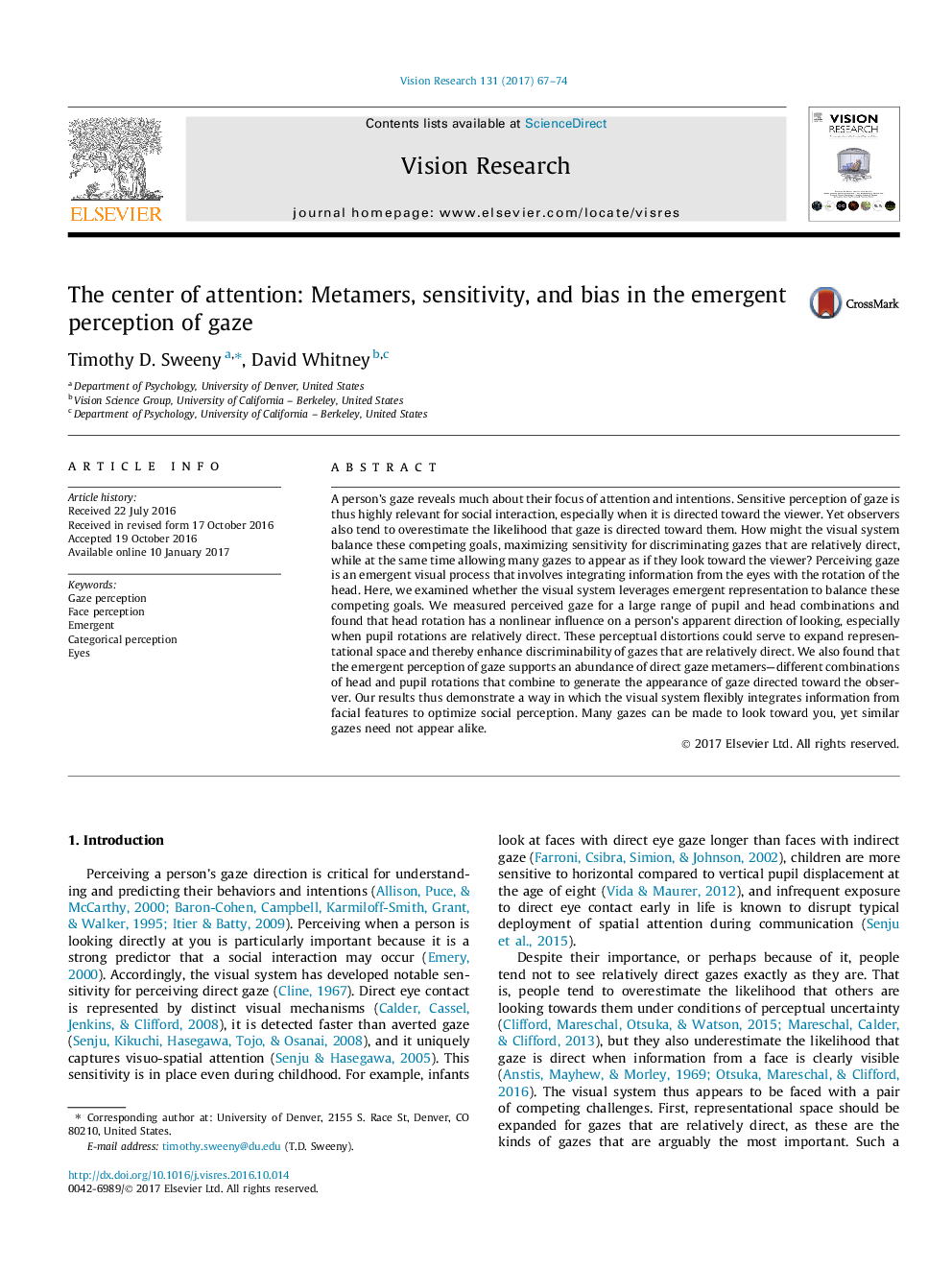| کد مقاله | کد نشریه | سال انتشار | مقاله انگلیسی | نسخه تمام متن |
|---|---|---|---|---|
| 5705945 | 1603168 | 2017 | 8 صفحه PDF | دانلود رایگان |
عنوان انگلیسی مقاله ISI
The center of attention: Metamers, sensitivity, and bias in the emergent perception of gaze
ترجمه فارسی عنوان
مرکز توجه: متمرکز، حساسیت و تعصب در ادراک چشمگیر چشم انداز
دانلود مقاله + سفارش ترجمه
دانلود مقاله ISI انگلیسی
رایگان برای ایرانیان
کلمات کلیدی
ترجمه چکیده
نگاهی به شخص در مورد تمرکز توجه و نیت خود را نشان می دهد. بنابراین درک حساس از دیدگاه، برای تعامل اجتماعی بسیار مهم است، به خصوص وقتی که آن را به سوی بیننده هدایت می کند. با این حال، ناظران نیز تمایل دارند که این احتمال را که چشم به سمت آنها هدایت می شود را بیش از حد ارزیابی کند. چگونه می توان سیستم بصری این اهداف رقابتی را تعادل داد، حداکثر حساسیت برای دیدگاه های گسسته که نسبتا مستقیم هستند، در حالی که در عین حال اجازه می دهد که بسیاری از چشم ها به نظر می رسد به نظر می رسد به سمت بیننده؟ درک دید یک فرآیند بصری ظهور است که شامل ادغام اطلاعات از چشم با چرخش سر است. در اینجا، ما بررسی کردیم که آیا سیستم بصری ارزیابی نمایندگی ظهور را برای تعادل این اهداف رقابتی دارد. ما چشم های درک شده را برای طیف وسیعی از ترکیب دانش آموز و سر اندازه اندازه گیری کردیم و متوجه شدیم که چرخش سر یک تاثیر غیرخطی بر روی جهت ظاهری فرد به دنبال دارد، به ویژه هنگامی که چرخش دانش آموزان نسبتا مستقیم است. این تحریفات ادراکی می تواند به گسترش فضای نمایندگی کمک کند و به این ترتیب تبعیض پذیری از دیدگاه های نسبتا مستقیم را افزایش دهد. ما همچنین دریافتیم که درک چشمگیر چشم انداز، فراوانی متامهای بینایی مستقیم، ترکیبی از چرخش های سر و شاخی است که ترکیبی از تولید ظاهر نگاه به سمت ناظر است. بنابراین نتایج ما نشان می دهد که یک سیستم بصری به طور انعطاف پذیر اطلاعات را از ویژگی های صورت به منظور بهینه سازی ادراک اجتماعی ادغام می کند. بسیاری از چشم ها را می توان به سمت شما نگاه کرد، اما نگاه های مشابه به نظر نمی آیند.
موضوعات مرتبط
علوم زیستی و بیوفناوری
علم عصب شناسی
سیستم های حسی
چکیده انگلیسی
A person's gaze reveals much about their focus of attention and intentions. Sensitive perception of gaze is thus highly relevant for social interaction, especially when it is directed toward the viewer. Yet observers also tend to overestimate the likelihood that gaze is directed toward them. How might the visual system balance these competing goals, maximizing sensitivity for discriminating gazes that are relatively direct, while at the same time allowing many gazes to appear as if they look toward the viewer? Perceiving gaze is an emergent visual process that involves integrating information from the eyes with the rotation of the head. Here, we examined whether the visual system leverages emergent representation to balance these competing goals. We measured perceived gaze for a large range of pupil and head combinations and found that head rotation has a nonlinear influence on a person's apparent direction of looking, especially when pupil rotations are relatively direct. These perceptual distortions could serve to expand representational space and thereby enhance discriminability of gazes that are relatively direct. We also found that the emergent perception of gaze supports an abundance of direct gaze metamers-different combinations of head and pupil rotations that combine to generate the appearance of gaze directed toward the observer. Our results thus demonstrate a way in which the visual system flexibly integrates information from facial features to optimize social perception. Many gazes can be made to look toward you, yet similar gazes need not appear alike.
ناشر
Database: Elsevier - ScienceDirect (ساینس دایرکت)
Journal: Vision Research - Volume 131, February 2017, Pages 67-74
Journal: Vision Research - Volume 131, February 2017, Pages 67-74
نویسندگان
Timothy D. Sweeny, David Whitney,
